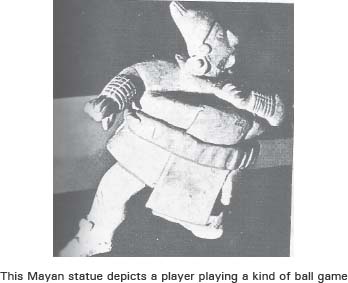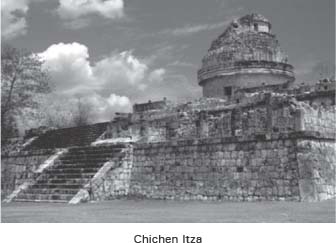
Archaeology in America is in infancy. Still, we have discovered a civilization par excellence. This civilization was called the Mayas. they were far ahead of the Egyptians and Greeks. They had the knowledge of Zero and built impressive architecture.
The world is still waiting for documents to prove that how did these people build up such a magnificent civilization at a place, where even today, life is an unending struggle for survival? How was it that a fourishing civilization was created by the people of Stone age? And who were these people whose classical age collapsed before even Columbus could discover America?
Some scholars were exploring the forests of Middle America. Suddenly they discovered some mounds covering the buildings. These buildings were apparently ruined by the forest. It was also clear that these buildings were no ordinary structures. They were remnants of a great civilization. The scholars got interested and started excavating. They discovered the remains of al fourishing civilization—the Mayas, as they named it. Thus, it was as late as in the 19th century that the secrets of a new civilization were revealed.
For sometime, the scholars believed that Mayas must have been the descendants of ancient Egyptians or one of the lost tribes of Israel. Maybe, the Mayan culture might have been founded by the Greek colonists or Scythians or even by the Chinese and South East Asia’s immigrants. But they could not come to a unanimous decision. Nonetheless, the fact remains that even today Mayan culture is one of the most fascinating ancient civilizations. Its vast buildings with modern lines, surrounded by impenetrable forest, force the scholars to discern their antecedents.

The civilization of the Mayas was situated in the heart of Middle America. It covered an area equivalent to France and spread across Guatemala, Belize and some parts of Mexico, Honduras and EI Salvador. The civilization started somewhere in 2500 B.C. and continued its progress till 34 centuries. Throughout their period of progress, they curtailed and struggled against the invading forest. They used to burn off the plant cover and made the land fertile for cultivation. Their staple food was maize but with it, they also grew various small plants which ultimately prevented the land from becoming infertile. however, this process was quite strenuous for the land remained fertile for a short time and then they had to repeat the process elsewhere. Despite such time-consuming practice, they found time to build remarkable buildings with good mortar, sandstone and volcanic rock.

Like the Egyptians, even the Mayas believed in eternity. And like the pyramids of Egypt, even Mayas built temples in the shape of pyramids. The head of these were priests who had such accurate knowledge of mathematical and astronomical tables which even Europeans did not know. The Mayas knew the art of writing, which perhaps, was one of the reasons for their being so successful. Some of Mayas texts are found on stone tablets, wooden panels, on pottery and in books made of vegetable fibre paper. These books have been written in 800 hieroglyphic signs. Fortunately quarter of their text had been deciphered. Their language is quite similar to ancient Egyptians and modern Japanese. It was written in a complex hieroglyphic script and composed of ideograms which represented words or ideas and partly had phonetic symbols for sound. However, not all of their language is known Scholars are still busy in trying to unravel the mystery of the language.
In mathematics also, they were better than other civilizations. They were well acquainted with the idea of zero. Because of their acquaintance with the zero, the Mayas were able to express any number by the use of three symbols: the dot, the bar or dash, and a shell shape for zero. While the Greeks, despite being innovative, wrote numbers by using letter of the alphabet and the Romans used graphic system which meant writing four figures, e.g. if they had to write 8; they write VIII. As the Mayas were primarily agriculturists, the knowledge of seasons and time was necessary. To know the accurate season and time, Mayas invented calendar. They divided their year into 18 months of 20 days. To this, they added five extra days and called it haab. These 360 days were called Tun by them. To date important events, they based the system on three different time scales – the solar year, the religious year and the venusian year. The Mayas calculated that 405 full moons occurred in a period of 11,960 days. Today’s astronomers make it 11,959.888 days. So, the Mayas were wrong in their calculation by one day every 292 years or to be precise less than five minutes, a year. They fixed the venusian year, i.e. the time which the planet takes to make a complete circuit of the sun at 584 days. The current calculation is 583.92 days. Thus, they increased by six minutes, a month. This is their achievement for they calculated all this without any elementary system of hour glass or a water clock or a telescopic instrument.
The archaeologists have divided the Mayan civilization into three periods. The periods from 2500 B.C. to 300 B.C. is known as the formative period. This was followed by the so called pre-classical period. And next came the classical age which extended for 600 years and was in full bloom in Peten. A great renaissance took place in Yucatan and it took the thread of classical period from Peten. The Mayas’ civilization in Yucatan bloomed from the 8th to the 10th centuries.
The Mayas’ empire was divided into small political units. These units were bound to each other with culture, religion and a uniform system of writing. But each unit had its own government policies and above all, had its own unique style in architecture and arts.
The highest authority in each unit or city was priest, who was authorised with the religious and civil powers, somewhat similar to Egyptian pharaohs.
The Mayas’ society was divided into classes. Beneath the ruler and his nobles were craftsmen and then peasants. The peasants were in large numbers and they did not disappear when the Conquistadores arrived. These people can still be found at places like Muna where they live in thatched wattle and daub huts and they still talk in the old Mayan language.
Besides their language, Mayas contributed to the world by their splendid architecture. Their buildings were very large. Some of them were as high as 230 ft. with a base of upto 130 by 130 ft. The slopes are steep with a dizzying stairway. At the top of the structure is often placed the shrine of the Mayan Gods. The design which adorn the Mayas’ palaces and towering structures is often geometrical and each elaborate face is carved to the precise design.
The culture with such advancement also succumbed to the law of nature, every rise has a fall. For many years, their end baffed historians and archaeologists. They supposed the reason for decline was epidemics and famines. Some reasoned it due to the internal wars. While some theorists lay the blame on the recurrent attacks by the nomadic tribes. These recurrent attacks, theorists argue, must have weakened the refned, complex structure of the life of Mayas. Most of the scholars agree on the last possibility.
Thus, going by the above reason, the internal wars from 13th to 16th centuries must have broken down the entire civilization. Therefore, when the Spaniards came at Yucatan in the 16th century, they were met by only the primitive descendants of the most advanced cultures.
In addition to it, Spaniards were least bothered about the Mayas culture. The Spanish bishop Diego de Landa organized a series of solomn ceremonies at which the historical, religious and scientific writings of the Mayas were burnt. And all this was done in the name of Inquisition. Prior to this Inquisition ceremony, he had written a book, “Account of the Affairs of Yucatan” in 1566. In this book, he had written about the Mayan people and their life style. But the book by no account can suffice the loss which we incurred by the mass burning of the Mayas literature. Perhaps, it would have revealed to us more about the mysterious and rich culture:
